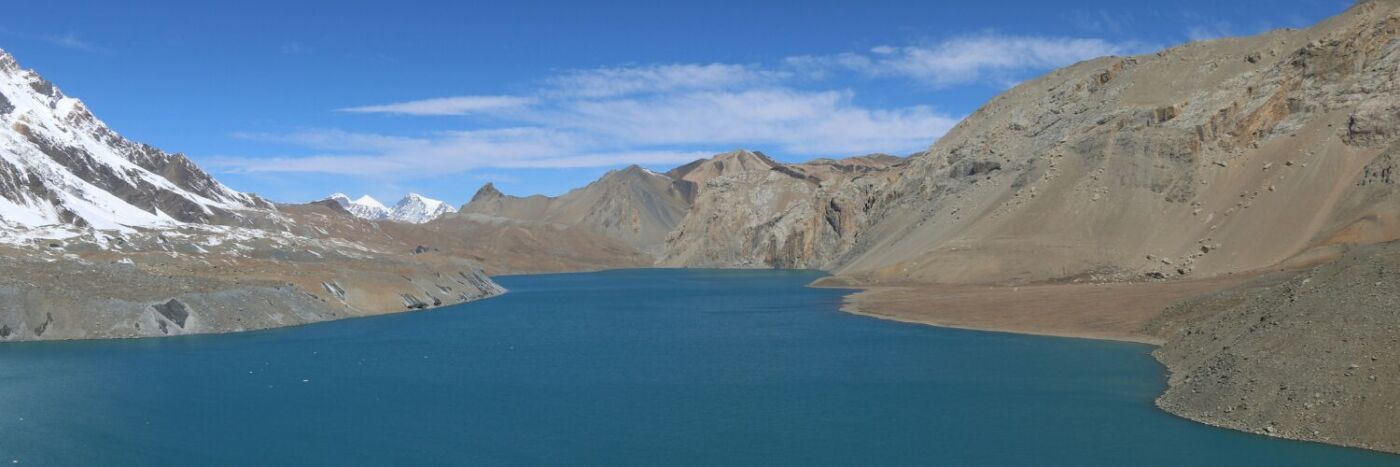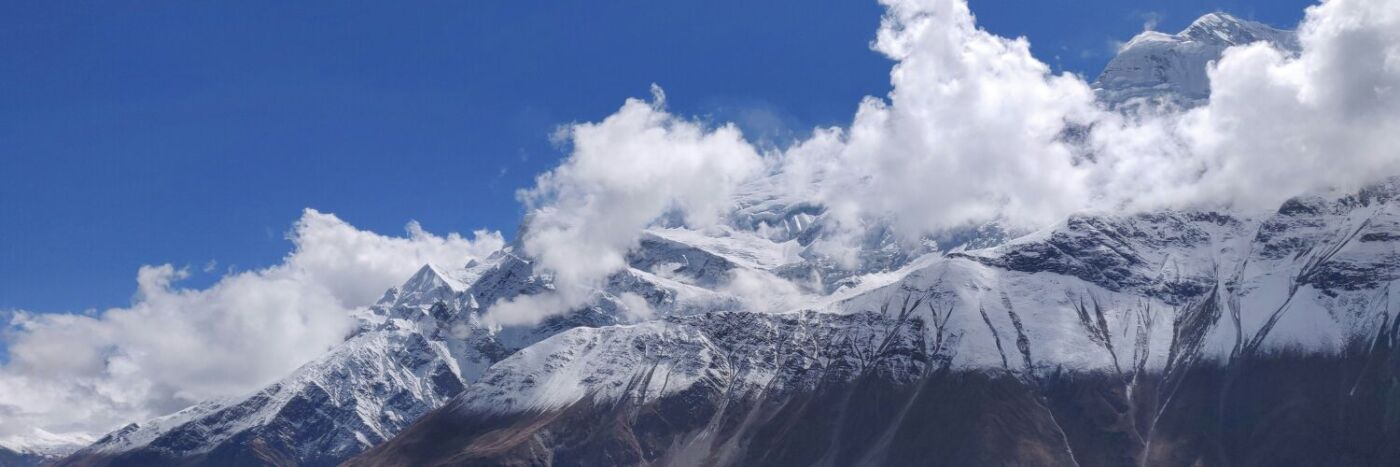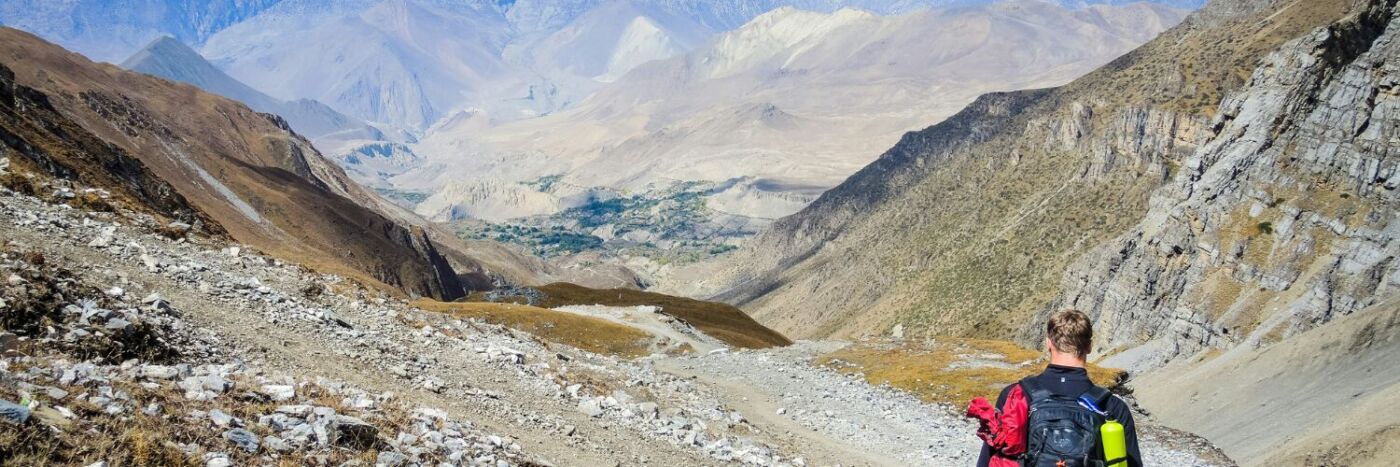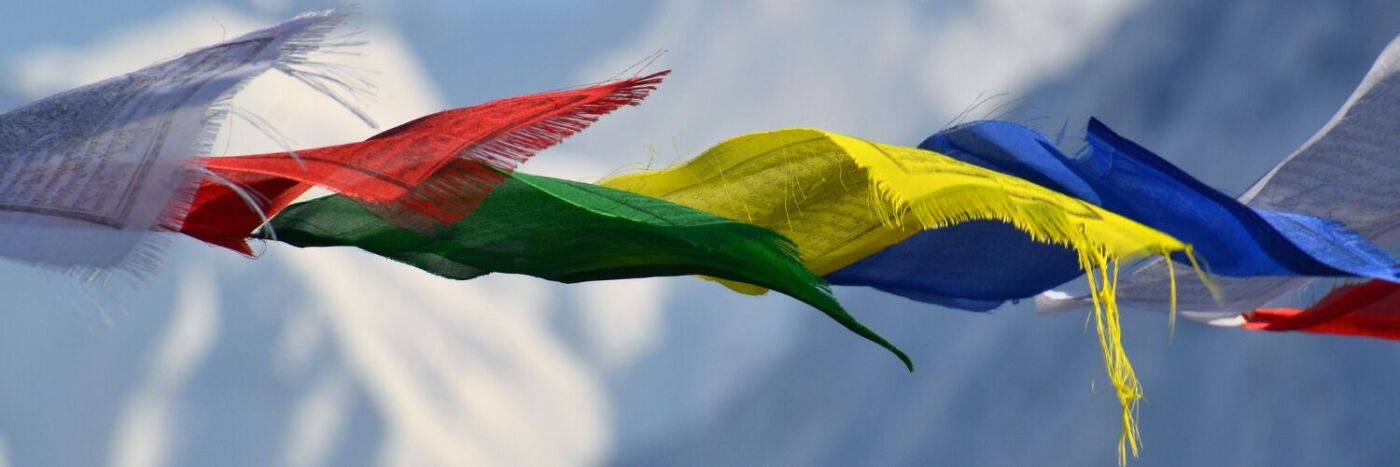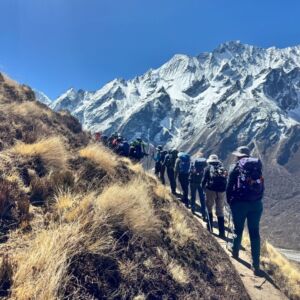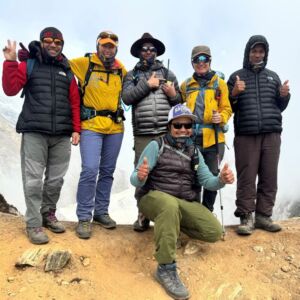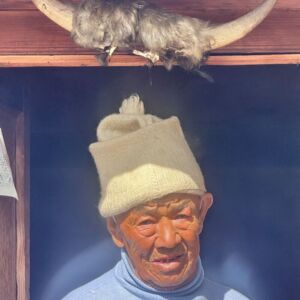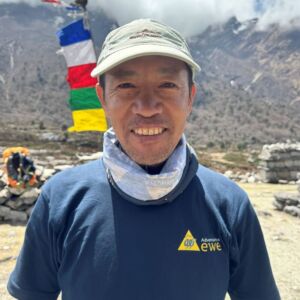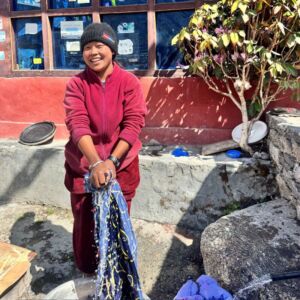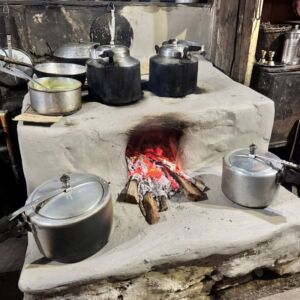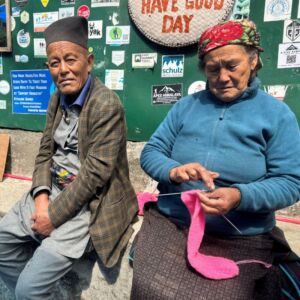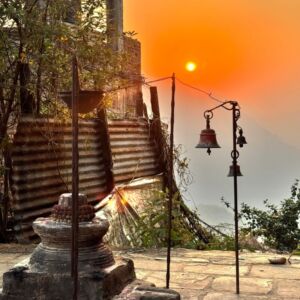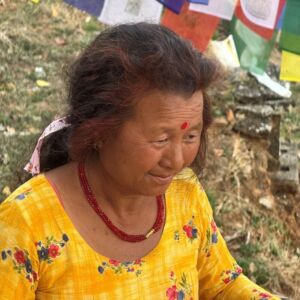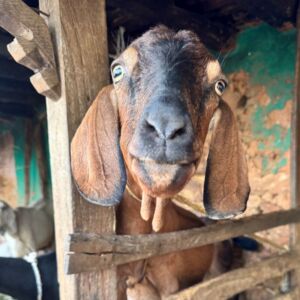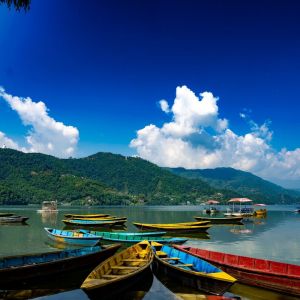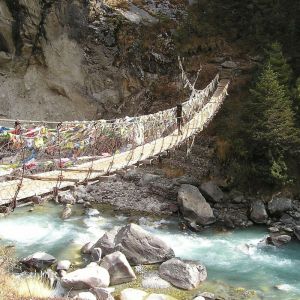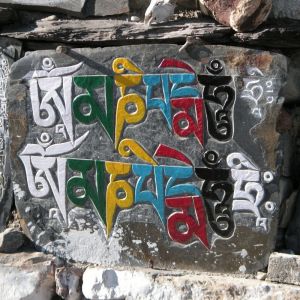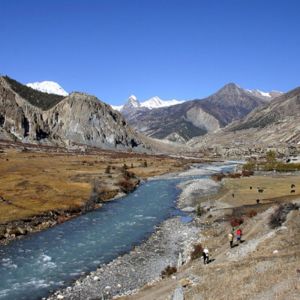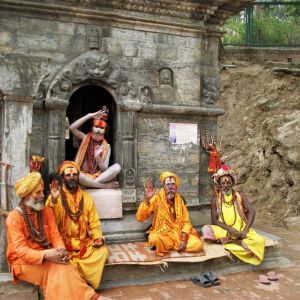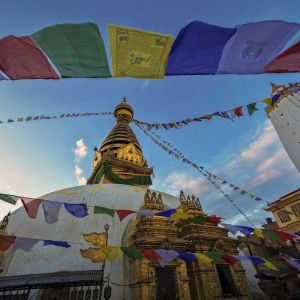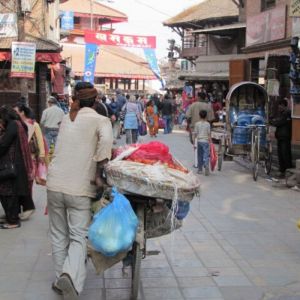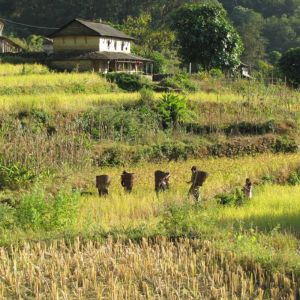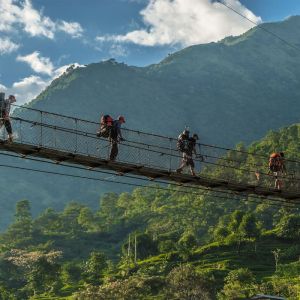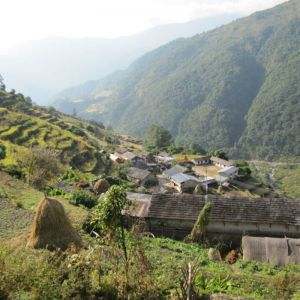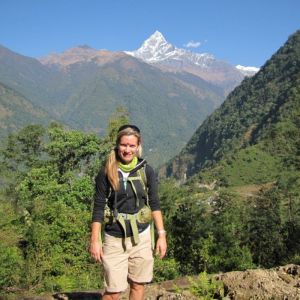- Overview
- Map & Itinerary
- Essential Info
- Pics & Vids
- Dates & Prices
Highlights
- Exclusively created for a private group – this tailormade adventure is available by invitation only
-
Stand in awe at Tilicho Lake – a turquoise gem nestled high in the Himalayas
-
Cross Thorung La Pass (5,416m) – the world’s highest trekking pass
-
Escape the crowds on remote trails through wild valleys and hidden villages
-
Discover Himalayan culture, sacred sites, and timeless gompas
-
Travel the AE way – small groups, expert local crews, and handpicked stays
- Free AE Water-to-Go Bottle included to help cut down on single-use plastics in Nepal.
Overview
This is not just a trek – it’s a journey through some of the most breathtaking and lesser-trodden corners of Nepal’s Annapurna region. From ancient villages to sky-high passes, sacred temples to remote alpine lakes, this 16-day adventure is packed with memorable moments.
You’ll stand at the edge of Tilicho Lake – one of the highest and most stunning alpine lakes on the planet – its turquoise waters glistening beneath a wall of snow-dusted Himalayan peaks. You’ll cross the legendary Thorung La Pass (5,416m), the world’s highest trekking pass. Along the way, you’ll dive deep into Himalayan culture – exploring timeless gompas, remote monasteries, and sacred pilgrimage towns like Muktinath.
This is mountain trekking at its finest – where tracks give way to narrow cliff-side trails, valleys stretch endlessly, and each bend in the path reveals something extraordinary.
And of course, you’ll do it the Adventurous Ewe way – in a small, supportive group with expert local guides, carefully chosen tea houses and hotels, and sustainability at the heart of your journey. You’ll even receive a free Water-to-Go bottle to help cut down on single-use plastics in this incredible but fragile environment of Nepal.
Whether you’re chasing high-altitude challenge, culture-rich connection or just the thrill of exploring somewhere new – this is your call to adventure.
Arrival in Kathmandu Nepal (1400m)
Welcome to the chaotic charm of Kathmandu! A city where ancient temples and prayer flags meet bustling markets and honking rickshaws. On arrival, you’ll be met at the airport for your included group transfer to the centrally located Kathmandu Guest House, nestled in the heart of colourful Thamel.
Please note: One group transfer is provided at a designated time. If you’re arriving outside of this window, you’re very welcome to arrange your own transport, book a private transfer through us for an additional cost, or simply hop in a local taxi.
Once settled in, you’ll meet your fellow trekkers and your Adventurous Ewe Mountain Leader for a pre-trek briefing and final preparations before heading out for a welcome dinner. Let the countdown to the Himalayas begin!
Included
Transfer: Airport transfer (one group transfer)
Accommodation: Kathmandu Guesthouse or similar (twin share basis)
Meals:Dinner only
Free day in Kathmandu
Today is yours to explore the vibrant chaos and cultural treasures of Kathmandu at your own pace. Whether you’re up for wandering the bustling alleyways of Thamel in search of souvenirs, sipping masala chai in a quiet rooftop café, or diving into the city’s spiritual side with a visit to Boudhanath Stupa or Swayambhunath (Monkey Temple), there’s something here for everyone.
Cultural Explorations
- Visit Pashupatinath, one of the most sacred Hindu temples, to witness ancient rituals along the Bagmati River.
- Walk the kora with pilgrims around Boudhanath, one of the largest stupas in the world.
- Soak up panoramic views from Swayambhunath, Kathmandu’s iconic hilltop stupa.
Markets & Crafts
- Pick up local handicrafts, prayer flags, yak wool scarves or singing bowls in Thamel or Patan’s Durbar Square.
- Visit the Garden of Dreams for a peaceful escape in the heart of the city.
Optional Activities
This is a chance to unwind, reflect on your adventure so far, and absorb the rhythm of Nepalese daily life.
Included
Accommodation: Kathmandu Guesthouse (twin share basis)
Meals: Breakfast only
If you’d like help booking a local cooking class, Ayurvedic massage, or guided city tour, just let your guide or the AE team know – we’re happy to help!
Roadtrip to Bandipur (1,030m)
Leaving behind the bustle of Kathmandu, you’ll travel west toward Pokhara before turning off the main highway and winding your way up to the charming hilltop town of Bandipur – a scenic drive of approximately 5.5 hours. Perched like an eagle’s nest above the Marsyangdi Valley, Bandipur is a peaceful, car free gem filled with traditional Newari architecture, cobbled laneways, and stunning views of the Himalayan foothills. We’ve included a night here to break up the long journey to your trek start point at Chame.
This afternoon, soak up the slower pace of life with a gentle stroll around the village. Wander its alleyways, sip tea in the quiet bazaar square, and watch local life as the sun begins to dip behind the hills. With its warm welcome and laid-back atmosphere, Bandipur offers the perfect glimpse into Nepal’s middle hills culture and countryside calm before the adventure ahead.
Included
Transfers: Private vehicle transfers
Accommodation: Basic Teahouse
Meals: Breakfast, lunch, dinner
Drive to Chame (2,670m)
This morning, you’ll descend from Bandipur to rejoin the highway before turning off toward Besisahar – the gateway to the Annapurna Conservation Area and once the official start of the classic Annapurna Circuit. The drive takes around 1.5 hours.
From here, buckle up for a rough-and-ready 4WD adventure as you climb deep into the Marsyangdi River Valley. It’s a long, bumpy and dusty road – but the dramatic scenery and first glimpse of high mountain life make it more than worth the ride.
After a total drive time of around 6.5 to 7.5 hours, you’ll arrive in the remote village of Chame, nestled beneath steep hillsides and prayer-flag-strewn forests. It’s here your trekking journey truly begins.
Included
Transfers: Private vehicle transfers
Accommodation: Basic Teahouse
Meals: Breakfast, lunch, dinner
Trek from Chame to Pisang (3,300m)
Lace up your boots – today you hit the trail. Leaving Chame behind, you’ll climb deeper into the Marsyangdi Valley, kicking off your trek with a crossing over a rushing side stream, followed by a long suspension bridge spanning the Marsyangdi River.
The path weaves through barley fields and pine forest, passing through the small village of Bhratang, once a settlement of Tibetan Khampa warriors. From here, the trail leads through dense woodland and climbs steadily over a ridgeline before opening into the upper Marsyangdi Valley. While the walk is mostly gentle, there are a few steeper sections to keep your heart rate at times, you’ll share the route with the jeep road, but the changing scenery and dramatic mountain backdrop make it well worth it.
You’ll finish the day in Pisang, a quiet village with epic views – and the perfect place to rest up and recharge for the journey ahead.
Trekking info
Trekking time: Approx. 6 hours
Included
Accommodation: Basic Teahouse
Meals: Breakfast, lunch, dinner
Trek from Pisang to Manang (3,540m)
Today’s trail is gentle and rewarding as you wind your way through a series of ancient Himalayan villages, each with its own character and charm. You’ll pass through Braga, where traditional stone houses are stacked one atop another, their rooftops doubling as the neighbours’ balconies.
Take a moment to visit Braga Gompa, the largest monastery in the Manang district, perched high on a cliff. Inside, you’ll find a treasure trove of centuries-old statues, thankas and manuscripts – a quiet yet powerful glimpse into the region’s spiritual heritage.
From here, a short walk leads you past prayer wheels and mani walls, across a stream and onto the wide, arid plains that signal your arrival in Manang – a lively village with a dramatic setting and some of the best views of the Annapurna range. On a clear day, the panorama is something you’ll want to take your time with – it’s simply spectacular.
Trekking info
Trekking time: Approx. 7 hours
Included
Accommodation: Basic Teahouse
Meals: Breakfast, lunch, dinner
Acclimatisation in Manang (3,540m)
Today is all about giving your body time to adjust to the altitude – a vital step before heading higher into the mountains. While it’s called an acclimatisation day, it’s not just for resting (though if you fancy a slower pace, Manang’s cafés and teahouses are perfect for that too).
The best way to support your acclimatisation is by hiking to a higher elevation and returning to sleep low. You’ll have a few great options for short day hikes, including a visit to the peaceful Bodzo Gompa, a walk to Gangapurna Lake, or a climb to the Chongkar viewpoint for sweeping views over the valley.
Whatever you choose, today helps you prepare for the next stage of your journey – and gives you a chance to explore more of this striking high-altitude landscape.
Included
Accommodation: Basic Teahouse
Meals: Breakfast, lunch, dinner
Trek from Manang to Shree Kharka (4,000m)
Today you’ll leave the main Annapurna Circuit behind as you cross the Khangsar Khola and head into quieter, wilder terrain. The trail starts with a gentle descent through cultivated fields before joining a broad track, with Gangapurna Lake slowly disappearing behind you.
Soon, you’ll pass above the confluence of the Khangsar and Jharsing Kholas, then cross a bridge before tackling a steep climb to a scenic ridge. From here, enjoy sweeping views back across the Manang Valley and surrounding peaks. The path levels out into a wide track as you walk through colourful alpine scrub – particularly vibrant in the autumn months. After another bridge and about an hour’s walk, you’ll reach the village of Khangsar, surrounded by golden wheat fields.
From here, it’s a steady uphill hike of around 2 hours to reach Shree Kharka. Your efforts are rewarded with panoramic views across the Annapurna wall, stretching from Gangapurna to Khangsar – a perfect preview of the landscapes to come.
Trekking info
Trekking time: Approx. 5 – 6 hours
Included
Accommodation: Basic Teahouse
Meals: Breakfast, lunch, dinner
Trek to Tilicho Base Camp (4,150m)
Today’s route is short but challenging, with exposed trails and steep terrain requiring steady focus and surefootedness. Leaving Shree Kharka, you’ll start with a gentle climb to reach a broad plateau, before crossing a suspension bridge that leads into a steep and slippery ascent.
The trail then levels out across the pastureland of Tho Kharka, weaving through patches of alpine scrub. Ahead, you’ll spot the narrow track etched into the bare scree slope – a dramatic stretch of the trail that’s both thrilling and demanding.
You’ll now enter the first landslide zone, a fragile traverse across a sheer slope with a steep drop to the river below. This section is around 1km long and typically takes 45 minutes to cross carefully. After rounding the ridge and tackling a few more undulations, you’ll face another exposed stretch before finally descending into the glacier-carved valley of Tilicho Base Camp.
Tucked below towering peaks, the base camp is stark, remote, and spectacular – your launchpad for tomorrow’s high-altitude highlight.
Trekking info
Trekking time: Approx. 3 hours
Included
Accommodation: Basic Teahouse
Meals: Breakfast, lunch, dinner
Trek to Tilicho Lake (4,949m) and Return to Shree Kharka
Today is a big day – and a truly spectacular one. You’ll start early to make the most of the morning light and calmer weather as you climb to one of the world’s highest lakes: Tilicho Lake, sitting at a breathtaking 4,949m.
The trail leaves Tilicho Base Camp with a short stream crossing before climbing the slope of a spur. From here, you’ll traverse onto the main ridge and begin a long, steady ascent on narrow, exposed paths. As you climb, soak in the dramatic views of the Annapurna Wall, The Grand Barrier, and the deep valleys carved by glacial streams far below.
Eventually, the gradient steepens as you take on a challenging set of switchbacks followed by a narrow ridge traverse. You’ll reach an uneven plateau, often snow-covered, passing two smaller lakes before finally arriving at Tilicho Lake – an awe-inspiring stretch of turquoise framed by snow-capped giants.
After time to absorb the beauty of this sacred, high-altitude lake, you’ll retrace your steps back to Tilicho Base Camp (approx. 2 hours) for lunch, then continue further down the trail to reach Shree Kharka (approx. 3 hours), where you’ll rest up after an epic Himalayan day.
Trekking info
Trekking time: Approx. 8 – 9 hours
Included
Accommodation: Basic Teahouse
Meals: Breakfast, lunch, dinner
Trek from Shree Kharka to Yak Kharka (4,018m)
This morning, you’ll rejoin the main Annapurna Circuit trail, following a gently rising path that leads you to Changyo in around an hour. From here, the route flattens out as you cross a wooden bridge over the Thorung Khola, eventually merging with the familiar trail at Ghyanchyang (approx. 3 hours).
With the river far below and vast ridgelines above, you’ll enjoy a more relaxed final stretch, continuing for another two hours to reach Yak Kharka – a peaceful alpine outpost surrounded by rugged hillsides and grazing yaks.
It’s a quieter day on the legs after yesterday’s high-altitude push, giving you time to rest, refuel and prepare for the climb ahead.
Trekking info
Trekking time: Approx. 6 hours
Included
Accommodation: Basic Teahouse
Meals: Breakfast, lunch, dinner
Trek from Yak Kharka to Thorung Phedi (4,450m)
Today you’ll take it slow and steady as you gain altitude en route to Thorung Phedi, the final stop before your big pass crossing. The trail climbs gradually, and given the thinner air and harsher conditions, taking your time is essential.
Reaching Phedi after around 4 hours, you’ll have the rest of the day to rest, acclimatise and prepare for the highest point of the trek – the mighty Thorung La Pass. Keeping your pace gentle today gives your body the best chance to adjust for the challenge that awaits tomorrow.
Trekking info
Trekking time: Approx. 4 hours
Included
Accommodation: Basic Teahouse
Meals: Breakfast, lunch, dinner
Cross Thorung La Pass (5,416m) and Trek to Muktinath (3,800m)
This is the big day – an early start sees you setting off in the dark for the long, steady ascent to Thorung La Pass (5,416m), the highest trekking pass on the Annapurna Circuit and the highest road-less pass in the world.
The trail climbs steeply right out of Thorung Phedi, but it’s well-defined and manageable if taken at a steady pace. After 4 – 6 hours of climbing, you’ll reach the top – marked by fluttering prayer flags, a chorten, and traveller-built stone cairns. The views here are nothing short of spectacular, stretching across the Annapurna and Mustang regions.
From the pass, it’s a steep descent towards Chabarbu, followed by a gentler trail through alpine meadows, deep ravines, and wide open paths. You’ll finish the day in the sacred pilgrimage town of Muktinath, revered by both Hindus and Buddhists, and home to ancient temples, flickering flames, and a powerful sense of peace.
It’s a very challenging day – but one that’s sure to stay with you for a long time to come.
Trekking info
Trekking time: Approx. 8 – 10 hours
Included
Accommodation: Basic Teahouse
Meals: Breakfast, lunch, dinner
Explore Muktinath and Trek to Jomsom (2,720m)
Start your morning with a visit to the sacred Muktinath Temple, an important pilgrimage site for both Hindus and Buddhists. It’s a peaceful 20-minute walk up a flight of stone steps from Ranipauwa, the cluster of lodges where you stayed overnight.
After soaking in the spiritual atmosphere, you’ll leave the paved roads behind and follow a more scenic, off-road route towards Jomsom. First, a gentle uphill trail leads you over Lupra Pass (3,770m) in about 1.5 hours, followed by a mostly downhill track through open terrain to reach the ancient Bon village of Lupra (approx. 1.5 hours). Don’t miss the 12th-century Bon monastery, one of the few remaining centres of this ancient shamanic tradition that predates Tibetan Buddhism.
From Lupra, you’ll follow the Panda Khola river, eventually crossing a bridge and briefly walking along a stretch of road toward Eklaibhatti. A suspension bridge takes you across the Kali Gandaki River, linking you with a quieter off-road path that leads through the village of Phalyak and down into Jomsom (approx. 1.5 hours).
Once settled in your lodge, you’ll have the option to explore the village of Thini and the peaceful Dumba Lake on the opposite side of the river – a great way to round off your final trekking day.
Trekking info
Trekking time: Approx. 6 hours
Included
Accommodation: Lodge
Meals: Breakfast, lunch, dinner
Fly to Pokhara and Enjoy a Free Afternoon
This morning, you’ll take a short but spectacular flight from Jomsom to Pokhara – a classic bush-plane experience soaring over the rugged Himalayan foothills, with snowy peaks gleaming just outside your window.
Once back in Pokhara, the rest of the day is yours to enjoy. After all your hard-earned kilometres, this is your chance to slow down, unwind and soak up the chilled-out vibe of Lakeside. Wander along the lakefront, sip a coffee or cool drink, and simply enjoy the feeling of having completed something epic.
In the evening, you’ll come together for a celebratory dinner at one of Pokhara’s laid-back restaurants – the perfect way to mark your journey with good food and great company.
Included
Accommodation: Basic Teahouse
Meals: Breakfast, dinner
Fly to Kathmandu and Explore the City
Enjoy a relaxed start before taking a late morning flight back to Kathmandu (approx. 25 mins), offering one last glimpse of the Himalayas from the air.
Once you’ve checked in at your hotel, the rest of the day is yours to spend as you like. You might choose to explore the vibrant local markets, pick up some last-minute souvenirs, or visit one of the city’s many historic temples and cultural landmarks. If you’d like to dive deeper into the city’s rich culture, visits to Kathmandu’s famed heritage sites can be arranged at an additional cost – just let us know.
Included
Accommodation: Kathmandu Guesthouse (twin share basis)
Meals: Breakfast, dinner
Return Home or Extend Your Adventure
It’s time to bid farewell to Nepal – but you’ll be heading home with a heart full of memories, epic achievements, and friendships forged on the trail. A group transfer to Kathmandu airport is included, timed to suit the majority of departing flights.
If you’re not quite ready to leave, why not extend your adventure? We’d be happy to help arrange extra accommodation or recommend experiences to make the most of your time in this incredible country.
Included
Transfer: Airport transfer (one group transfer)
Meals: Breakfast
Please note: the itinerary is subject to minor changes depending on flight arrival and departure times, weather, and group ability. However, the outline provided gives a good indication of the trek and what you can expect to experience.
Choosing the Annapurna & Tilicho Lake Trek isn’t just about reaching breathtaking altitudes or witnessing some of the most dramatic mountain scenery on Earth – it’s about being part of something bigger. This route takes you deep into local Himalayan communities, where tourism plays a vital role in supporting remote economies. From family-run teahouses in Manang to locally guided cultural encounters in villages like Braga and Lupra, your journey directly benefits the people who call these mountains home.
You’ll travel through the Annapurna Conservation Area, Nepal’s first and largest protected region – a pioneering model of sustainable tourism. The entry fees you contribute support conservation initiatives, trail maintenance, waste management, and the preservation of fragile mountain ecosystems. The region’s success is built on a powerful idea: that local people must lead and benefit from protecting their environment.
By trekking with us, you also minimise your impact. We operate in small groups, use refillable Water-to-Go bottles to cut single-use plastics, and work with experienced local crews who are paid fairly and trained in responsible travel practices. And we’ve designed this route to include acclimatisation days and off-the-beaten-track sections, ensuring slower travel, deeper connection, and more meaningful experiences.
This is your chance to walk with purpose – to explore one of the most beautiful corners of the Himalayas, while supporting Nepal’s commitment to a more sustainable, community-powered future.
We develop and host sustainable adventures to help support local communities and give you the chance to have a more meaningful travel experience. This exclusive expedition has been created in line with our Travelife Partner award in sustainable tourism.
When you book your Annapurna & Tilichio Lake Trek, you’ll get instant access to all your trip details through our free mobile travel app.
From your full itinerary and trip countdown to live updates, kit lists, local weather forecasts, and essential pre-departure info – it’s all right there in your pocket, 24/7. No bulky paperwork, no endless printouts—just everything you need, all in one place. It’s better for the planet, and much handier for you. A’ppy days indeed.
As a small family-run business, we pride ourselves on offering a personal, professional, and genuinely friendly service. We understand that everyone joins the Annapurna & Tilichio Lake Trek with their own story, experience level, and goals – so we’re here to support you with whatever you need, every step of the way.
From the moment you join the flock to the moment you return home, you’ll be supported by a team who’ve been there themselves – quite literally. We’re happy to chat through any questions, no matter how big or small. Whether it’s kit advice, altitude queries, or just reassurance, you’ll be able to speak directly with someone who truly gets it.
With decades of adventure experience between them, Jim and Sue have travelled and explored extensively across Nepal and beyond. Their insight and passion fuel every aspect of our expeditions – so you can feel confident, well-prepared, and inspired ahead of your Himalayan journey.
Flights are not included in your travel package, giving you the freedom to choose the best option for you – whether that’s flying from your nearest airport, using frequent flyer points, or extending your adventure in Nepal.
Once you book your Annapurna & Tilichio Lake Trek, we’ll send you the recommended group flight details. These timings include airport transfers in Kathmandu, so if you’re arriving on the group flight, everything’s taken care of. If you choose to arrive outside these times, it’s easy to take a taxi to the hotel, or we can arrange a private transfer at an additional cost.
You’re welcome to book flights directly with the airline or through our trusted flight agent, who is ATOL and ABTA protected. We work on a no-mark-up, no-commission basis – so you’ll only ever pay the direct cost of the flight.
And of course, if you have any questions or would like support with booking, just drop us a line at info@adventurousewe.co.uk – we’re here to help.
Internal flights in Nepal
Access to the high and remote areas of the Himalaya where the Everest Double Trek starts is often only possible using internal flights. The changeable nature of mountain weather makes flying conditions complex between Manthali Airport and Lukla Airport. In addition, the Civil Aviation Authority of Nepal does not operate to the same standards as those of western nations and all airlines in Nepal appear on the European Commission’s list of airlines that are banned from flying into EU member states. Flying in Nepal is an acknowledged risk, and the UK Foreign and Commonwealth Office travel advice provides further info.
Adventurous Ewe is mindful of its duty of care to you travelling with us in Nepal. There was an independent air audit of Nepal airlines undertaken by UK tour operators during 2017. From this Adventurous Ewe uses only four airlines in Nepal which were approved by this audit as safe carriers. These airlines are: Yeti Airlines, Tara Air, Buddha Air and Summit Air. In addition to this both Tara Air and Yeti Airlines have fulfilled the IATA Standard Safety Assessment (ISSA) – a global safety standard for commercial airlines operating smaller aircraft which you can learn more about by visiting: www.iata.org/whatwedo/safety/audit/issa/Pages/index.aspx.
We continue to cooperate with other tour operators to monitor aviation safety in Nepal. While we have taken appropriate action to try to minimise the risks of flying in Nepal, you should be aware that flying in mountainous terrain is not without any risk. Please note that poor weather can cause delays on internal flights. If at the start of your trip internal flights are cancelled for the day, you will spend an extra night near the airport and this may be at a hotel other than the group hotel. On the majority of trips there is enough flexibility in the trekking itinerary to make up 1 or possibly 2 lost days, but an alternative trek will be provided if internal flights are cancelled for a subsequent day. Helicopters can sometimes fly when the scheduled fixed wing aircraft cannot. If your group is offered the opportunity to use a chartered helicopter to reach the start point of the trek, the cost will be shared between those choosing to take this option.
Given the trek finishes with a return internal flight out of the mountains with currently no alternative road access, we have included 1 nights in Kathmandu as a contingency against delay. Should helicopters be able to fly during a period when fixed wings are cancelled, we will consider using these on a case by case basis to enable you to meet your international flights. In the extremely unlikely event that flight cancellations cause you to miss your homeward international flight, you will be responsible for re-booking your onward travel and for any associated costs. We advise you to take out suitable insurance and to keep your receipts, as you may subsequently be able to make a claim.
Road travel in Nepal can be a bumpy ride – both literally and figuratively – so it’s worth setting expectations ahead of time. While driving standards may differ from those at home, we go the extra mile to ensure your safety and comfort by using reliable, well-maintained vehicles and experienced drivers for all our transfers.
Please note that in Nepal, it’s not a legal requirement for rear seatbelts to be fitted in vehicles. While we do our best to use vehicles with rear seatbelts wherever possible, this cannot always be guaranteed. If you have any concerns about the vehicle or the standard of driving, please don’t hesitate to speak with your Leader straight away – we’re here to help.
Road conditions can vary significantly, especially due to ongoing infrastructure projects. Currently, major roadworks are taking place in and around Kathmandu, and delays, traffic congestion, dust, and uneven road surfaces are part of everyday travel. Demonstrations and strikes (bandhs) can also occasionally disrupt travel without warning. Patience and flexibility are key – and your Leader will always keep you updated and supported en route.
To enter Nepal, you’ll need a valid passport and visa. Please ensure your passport meets the following requirements:
-
Passport Validity: Your passport must be valid for at least 6 months from your date of arrival in Nepal.
-
Blank Pages: It must have at least one blank page for your visa stamp.
Important Notes:
-
Carry a printed copy of your visa confirmation if you apply online.
-
Always check the latest guidance before travel as requirements may change.
For up-to-date official advice, visit:
-
UK travellers: gov.uk Nepal Entry Requirements
-
Australian travellers: Smartraveller Nepal
All foreign nationals, except Indians, are required to have a valid visa to enter Nepal. A valid Nepalese visa, which can be obtained from Nepalese diplomatic missions outside Nepal or on arrival in-country, is also required to enter Nepal. Information regarding Nepalese visa and immigration can be found on the Government of Nepal’s website, www.nepalimmigration.gov.np. Please note, requirements often change and it is your responsibility to obtain any required visas for this trip. Therefore, we recommend that you check with the nearest embassy or consulate of your chosen destination(s), including any countries you may be transiting or transferring through.
Some local governments provide guidance on what visas their citizens need. To help, we’ve gathered a selection of useful links below.
- Australia: www.smartraveller.gov.au/destinations/asia/nepal
- Canada: www.travel.gc.ca/destinations/nepal
- United Kingdom: www.gov.uk/foreign-travel-advice/nepal/entry-requirements
- USA: www.travel.state.gov/content/travel/en/international-travel/International-Travel-Country-Information-Pages/Nepal.html
You can obtain your visa in advance or on entry. If possible, apply in advance as queues on arrival can be very long. Please note, the Immigration Department of Nepal has suspended visas on arrival for certain nationalities – please check if this applies to you with your nearest embassy or consulate .
When you arrive at Tribhuvan International Airport in Kathmandu, there will be three lines. If you have already secured you visa, go straight to the Immigration line. If not:
- Fill in a tourist visa form at the electronic kiosks. After inserting your passport, the machine will automatically fill out an application form, take an electronic photograph of you and print a paper slip. If the machine won’t read your passport, complete the details manually using the touchscreen. We recommend taking a passport photo with you just in case.
- Proceed to the visa fees collection counter and pay the visa fee (in cash, if possible). Make sure to keep the receipt.
- Go to the relevant immigration desk and present your tourist visa form, payment receipt and passport to obtain your 15-, 30- or 90-day visa stamp. Please check you have been given the correct visa duration.
Travel Insurance & Global Rescue
Travel insurance is a vital part of your Annapurna & Tilichio Lake Trek – and it’s compulsory for all participants. Your policy must include comprehensive cover for:
-
The full value of your trip
-
Medical expenses (including emergency evacuation and repatriation)
-
All activities undertaken on the trek including maximum altitude of 5,416m
-
Personal liability
-
Trip cancellation and curtailment
-
Loss of luggage and personal belongings and flight delays
-
Pandemic-related travel disruptions
For UK residents, we’ve partnered with Campbell Irvine Direct, a specialist insurance broker, to offer tailored travel insurance. If you’d like a quote for cover that aligns with our expedition requirements, visit here.
Important:
We suggest getting Travel Insurance cover once you have booked your trip.
Global Rescue Membership
For added peace of mind while trekking in remote mountain regions, we recommend short-term membership with Global Rescue. They provide expert support in medical, security, and evacuation services – offering protection up to $500,000 USD.
Unlike traditional insurance, Global Rescue acts immediately from the point of illness or injury. They’ll coordinate your evacuation to the nearest suitable medical facility for stabilisation, and once you’re fit to travel, they’ll arrange onward repatriation to your home hospital—with no claims process required.
All services are covered through a single, upfront membership fee. It’s a reassuring option for remote, high-altitude adventures.
For more information and to sign up, click here.
Leaders & Crew
Your Annapurna & Tilichio Lake Trek will be guided by a highly experienced and dedicated team, ensuring your journey is not only safe but deeply enriching and enjoyable.
Local Guides
Our Local Guides are the heartbeat of the expedition – bringing with them not only deep knowledge of the terrain but also the renowned warmth and hospitality of the Sherpa people. For them, mountain guiding isn’t just a job – it’s a lifelong passion.
You’ll feel their commitment in every step, whether it’s sharing local stories, adapting the pace to support you, or ensuring your safety and comfort throughout. They’re trained in altitude awareness and emergency procedures, and remain in constant communication with our Kathmandu office and Adventurous Ewe HQ via Garmin InReach, radio, and mobile.
Porter Welfare
We firmly believe that the well-being of our porters and mountain crew is essential. They are the soul of every expedition, and we treat them as valued team members, not just staff.
All our porters are:
-
Fairly paid
-
Properly insured
-
Provided with suitable clothing, meals, and accommodation
We work in line with international porter welfare standards and ensure everyone trekking with us – from porters to guides to participants – is looked after with respect and dignity. In the mountains, we’re all in it together.
Group Size & Private Departures
We proudly specialise in small group travel – not just for a more personal experience, but to minimise our environmental impact, enhance safety and wellbeing, and ensure a more authentic connection with the places and people you encounter.
The Annapurna & Tilichio Lake Trek requires a minimum of 6 people to run, with 12 also being the maximum group size. This allows for a close-knit, supportive team environment on the trail.
You’re very welcome to join this trip as a solo traveller, with friends, family, or colleagues – and many of our participants choose to do so as a charity fundraiser for a cause close to their heart.
If you have a group of 6+ people, we’d be delighted to organise a private departure tailored specifically for your team, charity, or organisation.
For more details or to chat about creating a bespoke Annapurna & Tilichio Lake Trek, drop us a line at info@adventurousewe.co.uk – we’d love to help make it happen.
This trek is graded as ‘Tough’ due to multiple consecutive days of trekking at high altitude, including several steep ascents and descents, and long days on the trail – with a maximum altitude of 5,416m at the Thorung La Pass. This is a physically demanding adventure that requires a good level of fitness, previous trekking experience, and a readiness to embrace the realities of high-altitude expedition life.
The route includes exposed sections, high mountain passes, and scree slopes, as well as crossing suspension bridges and landslide-prone areas. Trails are a mix of well-established paths, rocky tracks and narrow ridgelines.
Acclimatisation days are included to help you adjust, and your expert crew will be on hand to support you each step of the way.
If you’re a confident mountain walker with determination and a sense of adventure, this trek offers a truly rewarding challenge across some of Nepal’s wildest and most spectacular landscapes.
Altitude & Conditions
As you gain height, altitude-related symptoms such as shortness of breath, reduced appetite, disrupted sleep, and general fatigue are common. We’ve built in a considered acclimatisation programme to support you, but mental resilience and a team-focused mindset are just as important as physical stamina.
Be prepared for:
-
Basic accommodation in mountain lodges
-
Limited washing and toilet facilities
-
Cold temperatures, especially at night and higher altitudes
-
Rough terrain and long trekking days with a 35-litre daypack
This is not a luxury trip – it’s a real mountain experience. But with strong teamwork, guidance from expert leaders, and the right preparation, it is also an incredibly rewarding and transformative journey.
Who is this for?
This expedition is suitable for those who:
-
Have previous trekking experience, ideally in uneven or mountainous terrain
-
Are comfortable carrying a daypack for extended periods
-
Have a good level of general fitness and endurance
-
Are willing to embrace discomfort, stay flexible, and support their teammates
If you’re up for a true mountain challenge, the Annapurna & Tilichio Lake Trek offers one of the most powerful and meaningful adventures in the Himalayas.
Altitude Awareness & Acclimatisation
When trekking above 2,500 metres, your body must adjust to lower oxygen levels—a process known as acclimatisation. To support this, our Annapurna & Tilichio Lake Trek itinerary has been carefully structured to allow a gradual ascent, helping your body adapt and reduce the risk of Acute Mountain Sickness (AMS).
What to Expect at Altitude
As part of the acclimatisation process, you may experience symptoms such as:
-
Headaches
-
Tiredness or fatigue
-
Disturbed sleep
-
Shortness of breath
-
Loss of appetite
-
Nausea
-
Swelling of the hands and face
-
A racing heartbeat or palpitations
Everyone adjusts at their own pace. Most people experience some discomfort, such as headaches or sleep disruption, but in rare cases a person may require closer monitoring and care. Our experienced Leaders and Local Crew are trained in high altitude awareness and will be on hand at all times to support you.
Pre-Trek Briefing & On-Trail Support
Before setting off, we’ll provide a detailed altitude briefing, covering:
-
What AMS is and how to recognise symptoms
-
How to best manage and reduce risk
-
What to do if you or a teammate feel unwell
The most important rule: don’t ignore the signs. AMS isn’t something to fear – but it must be respected. If you feel unwell, always tell your Leader immediately. You’re in experienced and capable hands.
Our Altitude Safety Guidelines
To help your body acclimatise effectively, we recommend the following:
-
Drink 3–5 litres of water per day
-
Avoid alcohol, and limit caffeine
-
Walk slowly, even around lodges
-
Keep warm, especially at night
-
Eat regularly, even if your appetite dips
Our trips follow our High Altitude Policy as part of our Safety Management System, and our team is trained to make informed decisions in your best interest.
If you have a pre-existing medical condition (e.g. heart or lung issues) or are taking any medications that may impact your ability to acclimatise, please consult your doctor before booking.
Safety First
While we’ll do everything we can to help you reach your goal, your safety will always come first. In some cases, your Leader may make the call to delay or halt your ascent if they believe it’s necessary for your wellbeing. Please respect this decision – it’s made with your health and safety at heart.
High altitude trekking is a powerful and transformative experience – and with the right preparation, awareness, and team support, you’ll be ready to take it on.
Training
To help you get the most out of your expedition, we’ll provide you with a dedicated Trek Training Programme when you sign up. This guide will support your physical preparation and help you build the strength, stamina and resilience needed for trekking at altitude.
The more prepared you are, the more you’ll enjoy the challenge – both physically and mentally.
Top Training Tips:
Start Early – Begin training at least 3–6 months in advance. Build up gradually and stay consistent.
- Train on Hills & Uneven Terrain – Simulate the trek by walking on trails, hills and stairs while carrying a 35-litre daypack.
- Strengthen Your Legs & Core – Add strength training to your routine to help with long uphill stretches and balance on rough terrain.
- Add Stretching & Recovery – Incorporate yoga or flexibility work to improve recovery and reduce injury risk.
- Do Back-to-Back Days – Get your body used to trekking on consecutive days by training two days in a row.
- Listen to Your Body – Build endurance, not exhaustion. Rest days are just as important as training days.
- Walk Slow, Walk Long – Trekking isn’t about speed. Focus on long-distance walking at a steady pace.
- Hydrate & Fuel Properly – Practise drinking regularly and eating on the move—this will be essential at altitude.
And remember…
Train hard, smile harder, and enjoy the journey! 😊
Need help adapting the plan to your fitness level? Just let us know – we’re here to support you every step of the way.
Kit & Equipment
A full and detailed kit list will be provided upon registration for this expedition, helping you prepare for the conditions and challenges ahead. When it comes to high-altitude expeditions, having the right gear is key to your comfort, safety, and enjoyment.
Essential Trekking Kit
- Well-worn waterproof hiking boots – Your boots need to be supportive, waterproof, and broken in before the trek.
- Waterproof jacket and trousers – Mountain weather can change in moments; good waterproofs are essential.
- Warm layers, gloves, hat and buffs – Cold temperatures, especially at night and on summit day, require solid layering.
- 35-litre daypack – With room for daily essentials, snacks, and spare layers.
You’ll also receive exclusive Adventurous Ewe discount code for local specialist outdoor retailer Crib Goch Outdoor Shop – for quality mountain kit
Support for Porters
If you have any unwanted kit you’d like to donate – such as warm layers, waterproofs, or trekking gear – your Leader will collect it at the end of the trek. These items will be fairly distributed amongst the local porters and crew, many of whom rely on donations to stay equipped for future work. A small gesture from you can go a long way for those who support us in the mountains.
Any questions about kit or hiring equipment? We’re here to help – please drop us a line.
Weather in Nepal
The prime trekking season in Nepal runs from October to mid-May, when conditions are generally favourable for hiking. During this period, daytime temperatures are comfortable across most altitudes, with clear skies and only occasional rain or snow. However, mountain weather is always unpredictable, so it’s essential to come fully prepared for a range of conditions.
Temperature Ranges:
Kathmandu Valley: 15ºC – 35ºC
Annapurna Region (3,600m and above): Around 10ºC, dropping lower as you gain altitude
The Himalayas are wild and weather is always changeable, so be ready for anything – from blazing sunshine to sudden snowstorms or wind chill at altitude.
Your kit list and preparation will help ensure you’re well-equipped for a range of conditions, and your Leader will provide daily weather updates and advice while on the trail.
Any questions about what to expect? Just ask – we’re happy to help.
Accommodation
This expedition offers a variety of accommodation styles to reflect both the remote mountain environment and the cultural richness of Nepal. All accommodation is based on shared occupancy.
Kathmandu (3 nights)
We typically stay at the Kathmandu Guest House, located in the heart of the Thamel district. This charming hotel features en suite rooms, an on-site restaurant, a peaceful courtyard garden, and free Wi-Fi (available in the lobby and by login code in the rooms). It’s a comfortable and well-situated base for the start and end of your adventure.Tucked away in Kathmandu’s lively Thamel district, the Kathmandu Guest House has been a cherished haven for travellers since 1967. Once a grand Rana dynasty mansion, it has hosted an eclectic mix of guests – from mountaineers to artists – over the decades.
Teahouses (9 nights on trek)
Accommodation on the trek is in basic but adequate teahouses. Please be realistic about the standard – this is part of the adventure. Most teahouses provide:
-
Foam mattresses, sheets, and a pillow
-
Twin-share or dorm rooms
-
Unheated bedrooms – bring or hire a good quality sleeping bag
-
A central dining room (sometimes heated—fees may apply)
-
Simple toilets (mainly squat style, occasionally western)
-
Paid hot showers or buckets of hot water (Rs250–500)
-
Limited power for charging devices (Rs150–350 per hour)
Some of the teahouses we use are part of our local operator’s “Support Rural Nepal” project, which restores heritage buildings while generating employment for local artisans. In Bandipur (availability dependent), we aim to stay in one of these beautifully restored lodges that directly contribute to local livelihoods.
Important:
-
Wi-Fi is available in a few lodges, but it may be slow or unreliable.
-
Bring a head torch – lighting is often dim or inconsistent.
-
Most teahouses sell basic essentials (snacks, soap, tissues, toilet paper).
-
Dispose of toilet paper in the bins provided – never flush it.
The Old Inn, Bandipur (1 night)
With an enviable ‘eagle’s nest’ vantage point perched high above the Marshyangdi Valley, this tasteful, cozy Country Inn has uninterrupted views of the Himalayas. A new addition to the Old inn, but with its own very unique flavor, is the adjacent former ancestral mansion house where vintage architectural features and modernity combine seamlessly.
Hotel in Muktinath & Jomsom (2 nights)
On your return journey you’ll stay in comfortable hotels with ensuite bathrooms and hot showers in Muktinath & Jomsom.
Temple Tree Resort, Pokhara (1 night)
At the finish of your trek as a treat you’ll stay at the Temple Tree Resort with ensuite bathrooms and a great central location.
Single Supplements & Extra Nights
If you’d like a private room, we offer a single supplement for the hotel nights in Kathmandu (subject to availability). Single rooms in teahouses cannot be guaranteed and are not included in the supplement price, but if available on the day, you can pay locally for a room to yourself.
If you’re planning to arrive early or extend your stay in Kathmandu, we’d be happy to arrange additional nights of accommodation – please let us know at the time of booking or email us at info@adventurousewe.co.uk.
Have any questions about what to expect? Just drop us a message – we’re here to help!
Food & Drink
Your expedition includes 15 breakfasts, 12 lunches, and 15 dinners, with meals served in local teahouses and lodges throughout the trek. Dining in the mountains is part of the experience – simple, hearty, and often shared with fellow trekkers around a warm stove after a day on the trail.
Meals on Trek
Breakfast:
Expect a choice of:
-
Bread (toast, chapatti, or Tibetan bread)
-
Eggs (boiled, fried, or omelette)
-
Muesli or porridge
- Pancakes with jam/honey (on some days)
-
Tea or coffee
Please note:
Some remote teahouses have limited menus due to weather conditions, delivery schedules – so flexibility is key.
Lunch & Dinner:
Lunch is usually taken en route at a local teahouse, while dinner is served at the teahouse where you stay overnight. Menu options may include:
-
Dhal bhat (Nepal’s national dish of rice, lentils, and vegetables or meat)
-
Momos (steamed or fried dumplings)
-
Fried rice or noodles
-
Pasta and soups
Special Diets & Allergies
If you have a gluten-free diet, food choices will be limited. We recommend bringing your own snacks and supplements. Gluten is present in many soups and sauces.
For gluten-free trekkers, expect:
-
Vegetable fried rice and eggs
-
Trekker’s breakfast (no toast, extra egg) on certain days
Vegan or lactose-intolerant trekkers can expect:
-
Muesli or porridge with water
-
Vegetable fried rice
-
Trekker’s breakfast (no egg)
Your Leader will do their best to help, but options are basic in remote areas.
Snacks & Extras
If you’d like extra snacks, you can:
-
Bring your own from home (remove packaging beforehand to reduce waste)
-
Buy local snacks in Kathmandu or on trek to support the community
Please note that imported snacks and drinks on the trail are expensive.
Water
Drinking water is not included as part of your trip cost, and it’s important to come prepared to stay well-hydrated – especially at altitude, where you’ll need to drink at least 3 – 5 litres per day to stay healthy and aid acclimatisation.
We strongly encourage you not to buy bottled water on the trek, as this contributes to plastic waste in remote mountain areas.
Water Options & Filtration
- Boiled water is available to purchase at most teahouses (approx. Rs150–300 per litre, increasing with altitude).
- Water-to-Go Bottle – As part of your trip, you’ll receive a free Water-to-Go bottle, which contains a high-performance filter removing 99.99% of microbiological contaminants from any non-salt water source. Use this for refilling on the go from taps, streams, or lodge supplies. Please note: you cannot add flavourings or powders to this bottle as it may damage the filter.
- Water purification tablets – We recommend bringing tablets to treat water collected in your hydration bladder or other bottles if you wish to use flavourings or electrolytes. This is a handy alternative when you don’t want to use your Water-to-Go bottle.
Important Tip:
If your Water-to-Go filter freezes, let it defrost by placing it in lukewarm water for 10–15 minutes before use.
Using refillable bottles and filtration is not only safer for you – it helps protect the fragile mountain environment too. By reducing single-use plastic, you’re contributing to a more responsible way of trekking in Nepal.
Deposit: £225 per person on booking and non-refundable.
Balance: £2265 per person is due no later than 6 weeks prior to the trip start date.
Total cost: £2490 per person
Monthly payment plan
A monthly payment plan can be arranged for this trip. Please contact us for more information or to set up your plan. Simply email info@adventurousewe.co.uk or call 01492 588 069.
Book & Travel with Confidence
As well as carefully crafting amazing and meaningful adventures across the planet, we’ve made booking them as flexible, safe and as simple as possible.
For the latest info regarding booking and travelling with Adventurous Ewe, please visit our website.
Fundraising
You’re welcome to fundraise for a charity of your choice if you wish to do so. All sponsorship monies are to be sent directly to your chosen charity.
Your Adventurous Ewe Leader/s and Crew will have a satellite phone, mobile phones and radios communications in case of emergencies. The team are trained to deal with these situations. Please ensure you listen to your Leader during these times and refrain from putting any posts on social media. Should you find yourself unable to continue with the trek, your Leader and crew will make the necessary arrangements. Depending on the situation, you will be met by the support vehicle (depending on access) and you will be transferred back to suitable accommodation or nearby medical facility as required.
Your Emergency Contact at Adventurous Ewe HQ is Jim Young on +44(0)7747 346 588.
| Departure & Return | Duration | Availability | Deposit | Total Cost* | (*Total cost includes the deposit) |
| Oct 19, 2026 Nov 04, 2026 |
17 Days | Guaranteed to run | £225.00 | £2490.00 | Book Now |
What's Included?
PRE-TRIP:
- Personalised trip support in the lead up to your trek
- Trek training guide
- Discount on personal kit from independent outdoor retailers both in shop and online
- Trip info supplied via our free mobile travel app
- Financial Protection for your booking – ABTOT
- Monthly payment plan available
- Free Adventurous Ewe Water-to-Go Bottle
DURING YOUR TRIP:
Accommodation
- 3 nights at Kathmandu Guest House
- 1 night at The Old Inn, Bandipur
- 9 nights in basic mountain teahouses during the trek
- 2 nights in comfortable hotels with ensuite bathrooms and hot showers in Muktinath & Jomsom
- 1 night at Temple Tree Resort, Pokhara
Meals
- 15 x breakfasts, 12 x lunches, 15 x dinners
Transport
- All private transfers, including one group airport pick-up/drop-off and travel from Kathmandu to Chame via Bandipur (private van & jeeps)
- Internal flights: Jomsom to Pokhara and Pokhara to Kathmandu
Permits & Entry Fees
- Annapurna Conservation Area Permit (ACAP)
- Trekking Permit (TIMS or equivalent)
Trek Support Team
- English-speaking guide throughout the trip
- Assistant guides (1 for every 6–7 people; 2 for groups of 8)
- 1 porter for every 2 trekkers
- Adventurous Ewe UK Leader for groups of 6 or more
Additional Support
- Emergency satellite phone and oxygen for altitude-related emergencies
- All trip management before, during and post trek.
What's Not Included?
International Flights
Return flights to and from Kathmandu, Nepal. These can be arranged through our ATOL-protected flight agent at an additional cost.
Airport Transfers
If your flights fall outside our recommended times, private transfers in Nepal are not included but can be arranged on request.
Insurance
Comprehensive travel insurance that covers high-altitude trekking and helicopter evacuation is mandatory.
Visas & Vaccinations
- Nepal visa – Check latest guidance
- Recommended vaccinations – Refer to NHS Fit for Travel
Meals & Drinks
- Snacks, electrolytes and water purification tablets
- Meals not listed in the itinerary
- Alcoholic or soft beverages
Additional Tours & Entry Fees
Any activities, excursions or site visits not specified in the itinerary or inclusions list.
Teahouse Extras
Charges at teahouses for hot showers, battery charging, WIFI or additional amenities.
Personal Trekking Kit
Equipment and clothing as outlined on your kit list, plus any personal medication.
Other Essentials
- Tips for guides, assistant guides, porters, drivers and hotel staff (gratuities if earned)
- Any costs incurred due to leaving the trek early
- Personal spending money
- Single room supplements (where available)
TRIP EXTENSION
If you wish to extend your stay in Nepal, we can help you with plenty of recommendations of things to do and see. For more information, please contact us at info@adventurousewe.co.uk.
Sustainable and Responsible Travel
At Adventurous Ewe, sustainability is not a sideline – it’s built into every step of our expeditions. We’re proud to be a certified Travelife Partner, meeting over 100 criteria across environmental protection, fair labour, and ethical operations.
On the Annapurna & Tilicho Lake Trek, we’re committed to travelling responsibly by:
-
Employing local, qualified crew who are fairly paid and deeply experienced
-
Staying in family-run teahouses and eating in locally owned restaurants
-
Buying local produce to support mountain economies
-
Minimising plastic use – you’ll receive a free Water-To-Go bottle for your trek
-
Operating with a ‘leave no trace’ ethos – take only memories, leave only footprints
-
Respecting local customs, sacred sites, and cultural traditions
-
Contributing to the Support Rural Nepal initiative
-
Donating to Cool Earth, supporting forest conservation around the globe
We also encourage you to pack out any extra litter, ask permission before taking photos, and dress respectfully while travelling through villages and visiting temples. Together, our small steps add up to a big impact.
 Difficulty
Difficulty
